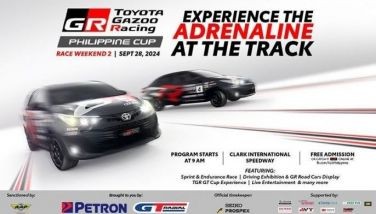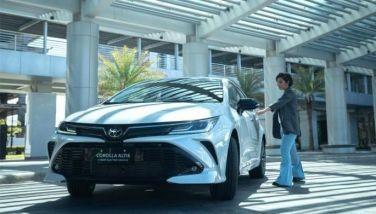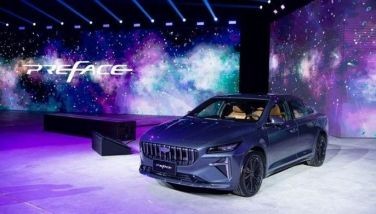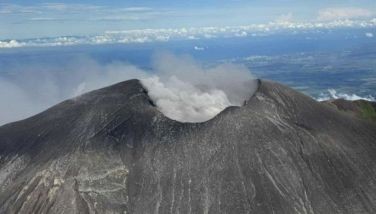Nissan's long road to market leadership
Do you remember the Datsun 180B (specifically the 1981 2-door model)? It’s the one with four rectangular headlights and rear opera windows. I betray my age but believe it or not, it was a status symbol back then. Okay, I was in high school then, not even old enough to drive. But I do recall that it was priced substantially higher than its equivalent 2-door rivals like the Colt Galant Lambda and the Toyota Corona “Macho Machine.”
Back then most of the 180Bs were silver or white. And back then, a 2-door or 4-door 180B – heck, any Datsun – was a status symbol. The equivalent Toyotas were always lower priced and had fewer features and amenities. The only cars locally available that surpassed Datsuns in prestige at that time were the Mercedes-Benz 200, the Opel Rekord, and the Renault 20TS. There were no BMWs, Volvos, and Audis back then, save for a few individually imported examples. So if you wanted to stand out in the late 70s and early 80s but couldn’t afford a Benz (or if you already had a Mercedes and needed a second car), you got a Datsun.
A 70s and 80s Datsun was the Subaru of its day. The more discerning buyers always seemed to prefer it over the more common Mitsubishi or Toyota. They wanted to stand out and were willing to pay more for the privilege.
Then before anyone knew it, Datsun became Nissan. The worldwide name change didn’t seem to matter much to buyers, both here and abroad. Locally available new cars were few and far between in the early to mid-80s. That time, most Filipinos only had the Ford Laser and Telstar, Nissan Stanza, and the box-type Mitsubishi Lancer to choose from. The Stanza was still highly regarded, despite it being the first generation of front-wheel-drive cars. (Many buyers – wary of front-wheel-drive – stuck with the rear-wheel-drive Lancer all the way to its 1987 GT model.)
Then came the box-type Sentras/Californias, followed by the Maxima. The 1987-90 Maxima was the Toyota Camry of its day, outselling the 1989 Corona that marked Toyota’s reentry to the Philippines (the Japanese subsidiary taking over Delta Motors Corp. as Philippine assembler and distributor).
At this point Nissan still had a respectable following and was held in high regard. Then came the onslaught of the first twin-cam 16-valve Toyota Corolla of 1989.
The utterly conventional box-type Sentra was powerless against the sheer appeal of the graceful new Corolla. (The then-new front-wheel-drive Mitsubishi Lancer EL, GL, and GLX provided more vigorous resistance but was still handily outsold by the Toyota XL, XE and GL.)
Nissan countered by fitting the 1989-90 Sentra SGX with all-power features. Still the Corolla dominated it, despite the Corolla’s non-power steering and manual-crank windows.
On the higher end, the Nissan Bluebird – the first locally assembled fuel-injected car in the Philippines – wasn’t selling in any decent numbers, falling far short of the public acceptance its Maxima predecessor enjoyed. The Bluebird’s successor, the awkwardly styled Altima, fared even worse. They were pummeled by the Mitsubishi Galant Super Saloon/GTI and Corona, respectively.
Then came Honda. And Nissan’s market share took a turn for the worse. The 1991 Sentra was the first in its class to boast electronic fuel injection, an available automatic transmission, a third brake light, rear defogger, cupholders, and a power antenna. It even had automatic speed-sensing door locks. But it wasn’t enough to turn back the Corolla and the Civic.
The larger and roomier 1995 Sentra Series III was Nissan’s bright point of the 90s. It wasn’t a best-seller, but it sold well enough and had very minimal problems to keep both Nissan dealers and owners happy.
Another bright point of that decade was the big and stately V6-powered Cefiro of 1998, which stood tall and proud against the equally accomplished Accord and Camry.
But two hot-selling models weren’t enough to sustain a relentless onslaught from a fast-growing industry. Suzuki, Mazda and Subaru had entered, the latter two via Columbian Motors; Ford joined shortly after – the Blue Oval eventually bringing the Mazda brand with it. Hyundai would come on strong as Hyundai Asia Resources Inc. (HARI), which took over from Francisco Motors Corp.’s distributorship. General Motors would come, too – first as Opel then as Chevrolet; the reasonably successful Optra preceding the handsome and widely admired Cruze.
And where has Nissan been throughout all these? From top 3 brand in the late 70s and early 80s to seemingly 4th, 5th, 6th, etc. with each new manufacturer joining the fray. Industry figures place Nissan Motor Philippines Inc. (NMPI) currently at 10th. As a brand, it would be 7th if sales of NMPI were combined with those of Universal Motors Corp.’s (UMC), the latter distributing Nissan’s commercial vehicles like the Navara pickup, Urvan, and Patrol.
Still that’s a long way off from its once envied top-of-mind position in buyers’ minds – at least in the Philippine market. In Japan and North America, Nissan sales have always been strong – enough to keep it in the top 3 among Japanese makes.
What happened here?
Was it the Datsun-to-Nissan name change? Hardly. Sales and public acceptance of the first Nissans, the Stanzas, remained strong.
Could it be inconsistent branding of its key models? (Something that’s hardly advisable if you’re building a brand.) From 180B, we got the Sentra, which Nissan tried to rebrand as “Sentra Exalta” in 2000 then back to just “Sentra.” (Toyota tried the same tactic with the Corolla Altis and it proved hugely successful.) The Maxima begat the Bluebird which begat the Altima which begat the Cefiro which begat the Teana – five different model names for basically the same vehicle class. Even UMC’s pickups have changed names with almost every new model.
In the meantime, the Civic and Accord have always been the Civic and Accord. Ditto the Lancer and Galant, two models that have retained their names for over three decades. For Toyota, the Corolla dallied with “Altis” and the Corona begat the Camry. At least the Altis and Camry have not undergone a name change in over a decade.
Personally I don’t think it’s the incessant name changing. Toyota changed the name of the Tamaraw to Revo to Innova with each new model – yet each new iteration became a bestseller.
Could it be the Vanette? It sold like hotcakes when it debuted in 1993 (it was on the market until 1997). Countless Nissan owners were put off by the Vanette’s perennial overheating problem, some requiring premature engine overhauls or even outright engine replacements. The Vanette could very well be a major factor in Nissan’s downward brand equity, especially for traumatized owners, many of whom swore to never again buy a Nissan.
Could it be pricing? Gone are the days when Datsuns commanded a premium. Today, with the many players on the market, high gas prices, and the ever-higher costs of living, pricing is definitely a make-or-break factor in vehicle purchases. And the current new Sentras are simply priced uncompetitively – though through no fault of the distributor or the dealers.
The new Sentra 200 is made in Mexico – Mexico being part of the North American Free Trade Agreement (NAFTA). But what’s good for American buyers is bad for Filipino buyers as most of the Sentra’s rivals are either made in the Philippines or in Thailand which enjoys ASEAN Free Trade Agreement (AFTA) status, giving them a substantial pricing advantage. Hence the 2-liter-only Sentra 200 retails for P1,150,000 while its rivals, which have 1.6- and 1.8-liter variants, start as low as P800,000. That’s a whopping P350,000 difference. Now you know why you hardly see new Sentra 200s on the road.
The Nissan Murano and Patrol Royale are two magnificent and state-of-the-art luxury SUVs – but they’re just too expensive to make them anything but niche models.
Could it be a lack of features, amenities and technology? Definitely not. Nissan was always ahead in introducing major new features and amenities, yet that almost never helped it command sales. Today, Nissans are every bit as advanced as any of its rivals. Name a state-of-the-art drivetrain, luxury or safety feature available in any of its competitors and you’ll find it in a Nissan.
Could it be something as simple and basic as styling? Now we’re getting somewhere. You don’t need an MBA to appreciate what Hyundai has accomplished in such a short time. One glance at the current Tucson, Sonata, Elantra and Accent and you’ll see why the brand has rocketed to the top of people’s wish lists. To think that just a decade ago, car buyers shied away from Korean-made cars. Even Mitsubishi’s Lancer transformed from wallflower to head-turner with one model change (although it’s still not selling as well as it should due to its P1 million-plus price points).
Unfortunately, the Sentra 200 and Teana sorely lack the sleekness and elegance found in their Civic, Altis, Camry and Sonata rivals. Many buyers will never know that those two Nissans actually have better build quality, better fuel economy, and a much more comfortable interior and ride than many of their competitors.
The same applies to the second-generation X-Trail, which looks too much like its predecessor (which itself was never a looker). Nissan could have done a Hyundai Tucson here. Cutting-edge all-wheel-drive is just not going to cut it.
Size matters, too. The Nissan Grand Livina could have been an Innova. On paper, Nissan’s 7-seater could have taken a bite out of the country’s best-selling people-carrier. Instead Nissan made the Grand Livina too small to make it a viable alternative to the Innova. (It also doesn’t have a diesel engine option.) Pitted against Toyota’s other (and smaller) 7-seater, the Avanza, the Grand Livina is just too expensive. Too bad many people are missing the Grand Livina’s refined cabin, very comfortable ride, and easy-to-drive attributes.
Style-wise, price-wise, and size-wise, the Navara pickup and Urvan are the only Nissans that can truly hold their own against their rivals.
So what’s Nissan to do to regain market share and brand equity? In the Philippine context, very little actually. Much depends on the Nissan headquarters in Japan and America – and on the local distributor’s available models from its base in Taiwan. As long as they can only give us cars that don’t click with local tastes or are just priced too high, buyers will shop elsewhere.
But make the next Sentra, Teana, and X-Trail genuine head-turners (and the next Grand Livina substantially bigger) – and price them competitively – and people will be flocking to Nissan showrooms.
It will help a lot too if Nissan had a subcompact car in the City/Vios class (the biggest selling segment in the Philippines) as well as a high-profit-margin/high-profile hatchback in the Jazz/Yaris/Swift class. Nissan actually has those models available overseas, so hopefully Nissan can find a way to bring them here.
Technology-wise, while Toyota leads the way in hybrid cars, Nissan is actually a leader in electric cars with its Leaf EV.
Globally, the Nissan brand is mighty and has a robust model range. They just announced “Nissan Power 88,” which includes globally launching an all-new vehicle on an average of once every six weeks for the next six years to increase its global market share and operating profit.
Let’s hope that some of those cars make it to our shores. The Philippines is a relatively simple market. Great looks and a good price, and you’ve got yourself a blockbuster.
As the voice whispered to Kevin Costner’s character in the movie Field of Dreams, “if you build it, they will come.”
- Latest






























